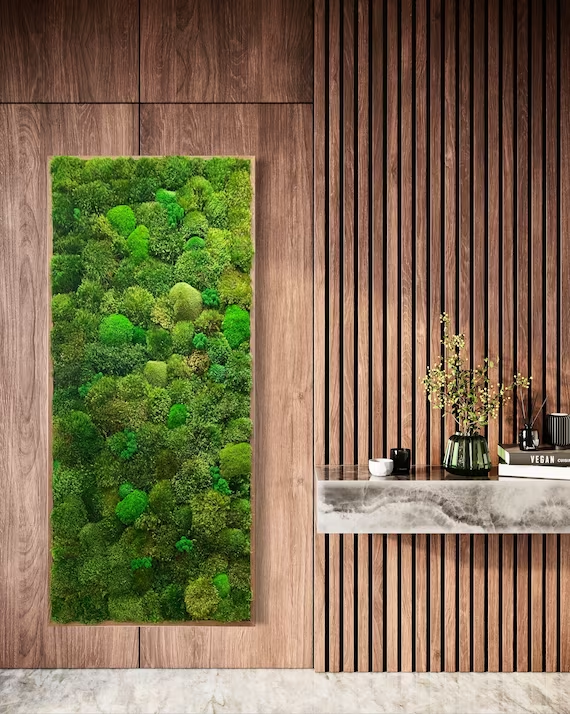Moss Art Walls Manufacturing
Moss art walls are a captivating blend of nature and design, combining the serenity of natural greenery with the creativity of modern interiors. They are crafted using preserved moss, which offers the lush, green aesthetic of live plants without the need for sunlight, water, or ongoing maintenance. The manufacturing of moss art walls is a meticulous process, requiring expertise in design, preservation techniques, and assembly. Below is an in-depth look at the process of moss art walls manufacturing.
1. Selection and Sourcing of Moss
The first step in manufacturing moss art walls is selecting high-quality moss. This can include different varieties like reindeer moss, flat moss, bun moss, and mood moss, each offering a distinct texture and color. Manufacturers often source moss from sustainable forests, ensuring that it is harvested without harming the environment.
Once harvested, the moss is cleaned and sorted according to its size, texture, and color. High-quality sourcing is crucial, as the moss must be healthy and vibrant to withstand the preservation process. Ethical manufacturers prioritize sustainable harvesting practices to ensure minimal environmental impact.
2. Preservation Process
Natural moss is preserved to maintain its appearance for years without the need for soil, water, or sunlight. The preservation process typically involves replacing the natural moisture in the moss with a glycerin-based solution. This solution prevents the moss from drying out or losing its lush texture, enabling it to retain its vibrant green color indefinitely.
The moss is soaked in this preservation solution for a set period, which allows it to absorb the necessary materials while maintaining its natural softness. Once preserved, the moss is carefully dried and prepared for application. The preserved moss retains its organic appearance but is no longer living, so it doesn’t require any of the typical care associated with live plants.
3. Design and Customization
Moss art walls are highly customizable, and the design phase is critical to the overall production. The manufacturer collaborates with clients to determine the desired size, shape, and style of the moss wall. These walls can range from simple, uniform panels to intricate patterns or even logos and custom shapes.
Designers often use software tools to visualize the final product and plan the layout of the moss on different surfaces. Some moss art walls incorporate other natural elements like wood, stone, or artificial plants to create a multi-textured, biophilic design.
4. Assembly and Installation
Once the design is finalized, the manufacturing process moves to assembly. The preserved moss is carefully arranged and adhered to a backing material, which could be a wooden frame, mesh, or another supportive surface. The choice of adhesive is essential, as it must hold the moss securely while being invisible in the final product.
The backing material is designed to be lightweight but durable, ensuring that the moss wall can be easily mounted. In large installations, moss art walls may be produced in panels that can be seamlessly connected on-site to form a continuous green expanse.
5. Quality Control and Finishing
After assembly, each moss art wall undergoes thorough quality control to ensure that the moss is evenly applied, the colors are vibrant, and the design matches the client’s specifications. Manufacturers inspect the product for any inconsistencies in texture or gaps in coverage and make necessary adjustments.
A protective finish may be applied to enhance the longevity of the moss wall. Although moss walls are naturally fire-retardant due to the glycerin preservation process, additional fire-resistant treatments are often applied in commercial projects for extra safety.
6. Shipping and Installation
Once completed, the moss art wall is packaged and shipped to the client. Some manufacturers offer installation services, ensuring that the wall is properly mounted and displayed. Large or complex installations might require professional handling to ensure that the moss is not damaged during the process.
7. Maintenance and Longevity
One of the key selling points of moss art walls is their low maintenance. Because the moss is preserved, it does not require watering, sunlight, or trimming. However, periodic dusting or cleaning may be necessary to maintain its aesthetic appearance. With proper care, moss art walls can last for 10 to 15 years, making them a sustainable, long-term decor solution.
Conclusion
Moss art walls are an innovative, sustainable design solution that adds a touch of nature to modern spaces without the complexities of maintaining live plants. The manufacturing process, from moss preservation to custom design and assembly, is a blend of artistry and technical skill. As demand for biophilic design grows, moss art wall manufacturing is poised to become a key player in the interior design industry, offering eco-friendly and visually stunning alternatives to traditional decor.
